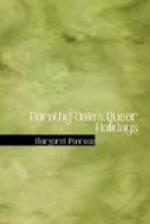Other tableaux followed, each one more or less well impersonated, until Tom and Agnes went at “The Maiden all Forlorn.”
As the “Man all Tattered and Tom,” Tom was a veritable scarecrow, with a fringe of rags all over him, and the familiar battered hat well turned down to conceal any accidental smile that might detract from his serious pose. He was bending over Agnes in the regulation picture-lover attitude, and as the curtains were pulled together Tom did what any other young man on earth might have done—he kissed the Maiden all Forlorn.
Everybody behind the scenes saw it.
“I never want to act with him again!” declared Agnes loudly and scornfully, as she scrubbed her offended cheek with her handkerchief. “Ned White is always a gentleman.”
Dorothy was sorry, but it seemed a natural joke. Every one but Agnes thought the same thing, but somehow the forlorn maiden could not be convinced that Tom was simply thoughtless in his joking.
The incident, trifling as it was, somewhat marred the good humor of the players. Roland came near falling for a second time in his “Jack be Nimble.” As it was, the big candlestick did topple over just as the curtain bell sounded. Then Edith Brownlie looked decidedly miserable as “The Queen was in the Kitchen, Eating Bread and Honey.” She liked Tom Scott—everybody knew that—and now Tom, in addition to having lately favored Dorothy, had kissed Agnes! Of course, the girls, and boys too, teased the sensitive Edith, and she lost interest in her picture.
Dorothy breathed a sigh of relief when Mary Mahon’s number was announced. Mary was actually quivering with excitement. She wanted to act, and Dorothy was confident that she would do well.
Her recitation was entitled “Guilty or Not Guilty?” and as she stepped out and made her bow, the house was hushed in silence. In a plaintive voice she began that well-known poem:
“She stood at the bar
of justice,
A creature
wan and wild,
In form too young for
a woman,
In feature
too old for a child.”
How the lines seemed to suit her! Surely the features of Mary were too old for those of a child. Her face had a drawn, pinched look, and her eyes were so deeply set.
But the pathos of her voice! When she pleaded with the judge for mercy against the charge that she was a thief she mentioned the starving children.
“I took—oh,
was it stealing?—
The bread
to give to them!”
The women pressed their handkerchiefs to their eyes. There was something almost too real in the child’s plea. Who was she? they asked. A professional?
Dorothy was delighted at Mary’s success. The girl was her “find,” and it was she who had taught her how to use her voice so well in the pathetic lines. True, she found an apt pupil in Mary, and Dorothy was but too glad to accord her the entire triumph, when the recitationist bowed again in response to the hearty applause and retired.




